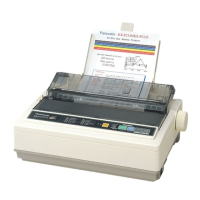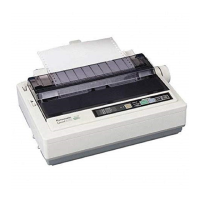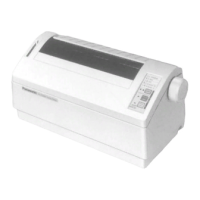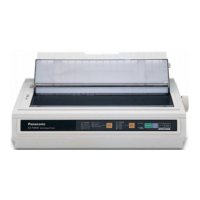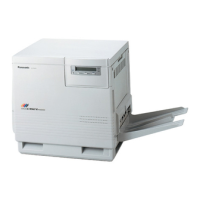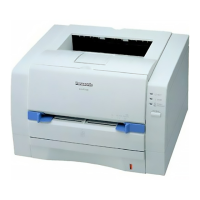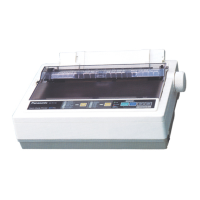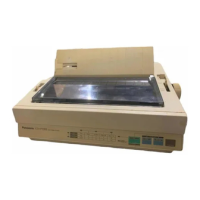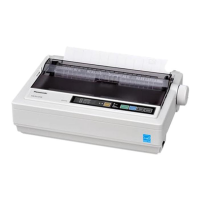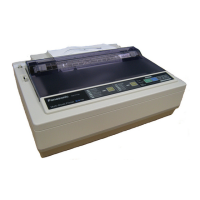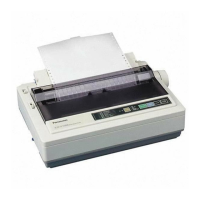Do you have a question about the Panasonic KX-P2123 and is the answer not in the manual?
Safety precautions for appliances with moulded three pin mains plugs.
Highlights the printer's versatility, EZ Set Operator Panel features, and printing capabilities.
Details technical specifications including power, interface, fonts, dot configuration, and dimensions.
Identifies external components of the printer through front, top, and rear views.
Specifies environmental conditions for printer operation, avoiding extreme temperatures or dust.
Guides on checking contents for damage and reporting any issues immediately.
Instructions for installing the platen knob and removing protective paper.
Details on plugging in the power cord and locating the power switch.
Step-by-step guide for inserting a new ribbon cassette into the printer.
Explains the use of TRACTOR and FRICTION modes for different paper types.
Describes the function of the paper feed selector and head gap lever.
Provides instructions for installing both Fanfold paper and Single Sheets/Envelopes.
Explains how to align characters using the ribbon mask line.
Details how to initiate a self-test to check printer functionality and fonts.
Instructions for establishing communication with a computer via a parallel interface cable.
Guidance on using software packages to configure printer settings and drivers.
Explains the seven switches and Control Table for printer operation.
Instructions for setting font, pitch, and form length using the Control Table.
Procedure for adjusting the left and right margins using printer controls.
Details on saving and recalling printer settings combinations as macros.
Instructions for recalling the printer's factory default settings.
Guide for selecting print colour when the optional colour kit is installed.
How to activate the mode that reduces printing noise and speed.
Explains Form Feed, Line Feed, Micro Line Feed, and Reverse Micro Line Feed functions.
Instructions for advancing fanfold paper to the tear position.
Details on loading and parking paper using the LOAD/PARK switch.
Function for parking single sheets or envelopes without wasting fanfold paper.
Procedure for setting the first print position on the paper.
Guide for selecting various printer configurations via the Control Table.
Explains the Paper Out, Overheat, and Overload detectors.
Conditions under which the printer is initialised and user clear function.
Mode for displaying data in hexadecimal code instead of normal ASCII characters.
Compatibility with Epson LQ-860 and IBM Proprinter X24E emulation modes.
Explains common language and coding schemes for printer communication.
Methods for entering control codes from the keyboard using BASIC commands.
Technique for embedding printer control commands within BASIC programs.
Procedure for inputting ASCII codes in hexadecimal format.
Categorizes control codes and explains their use in printer commands.
Details on specific codes for IBM PC compatibility and BASIC commands.
Covers print quality, font, style, pitch, and highlight options.
Instructions for customising characters and managing buffer capacity.
Explains the printer's capabilities for bit image and graphics printing.
Commands for selecting print quality, font style, and sub/superscript fonts.
Commands for setting Pica, Elite, Micron, and Compressed pitches.
Commands for Emphasized, Double High, Double Wide, and Outline printing.
Commands to enable Word Processing modes for alignment and justification.
Commands for selecting International, Graphic, and Alternate character sets.
Commands for selecting standard, double density, and speed graphics modes.
Commands for setting paper feed amounts for various increments.
Commands for setting page length in inches or lines and skip perforation.
Commands for setting and executing horizontal and vertical tabs.
Commands for carriage return, backspace, and print direction.
Commands for clearing data, selecting remote printers, and deleting characters.
Command to select print colour when the optional colour kit is installed.
Commands for selecting print style, font, and sub/superscript fonts in IBM mode.
Commands for setting Elite, Compressed, and Proportional pitches in IBM mode.
Commands for Emphasized, Double Strike, and Double Wide printing in IBM mode.
Commands for selecting IBM character sets and changing code pages.
Commands for selecting graphics modes and reassigning bit image density.
Commands for setting paper feed amounts in IBM mode.
Commands for setting page length and skip perforation in IBM mode.
Commands for setting and executing horizontal and vertical tabs in IBM mode.
Commands for carriage return, backspace, and print direction in IBM mode.
Commands for clearing data buffer and selecting/deselecting remote printers.
Command for selecting print colour in IBM mode.
Details on communication via Centronics standard, specifications, and pin configuration.
General care instructions to prevent damage and ensure longevity of the printer.
Information on ribbon life, replacement, and handling.
Table of common printer symptoms, possible causes, and probable solutions.
Charts showing Epson Italic, Graphic, and Multilingual character sets.
Charts displaying IBM Character Sets 1, 2, and All Character charts.
Table of international character sets available for the printer.
Tables detailing character widths for proportional spacing in Epson and IBM modes.
Character sets for Epson Multilingual, Portugal, Canada, and Norway.
Character tables for IBM mode, including Multilingual, Portugal, Canada, and Norway.
Provides the data structure for entries in the index table.
Blank matrices for designing downloadable draft characters.
Blank matrices for designing downloadable LQ characters.
Details paper types, sizes, and weights for fanfold, single sheets, and envelopes.
Illustrates printable areas for continuous and single sheet paper.
Definitions of technical terms used in the manual.
Defines control codes, control table, and character-related terms.
Explains various printing modes like double strike, high, and wide printing.
Defines download characters, draft, emulation, escape sequences, and fonts.
Defines interface types, parity, protocols, RAM, and ROM.
Defines terms like MSB, OFF LINE, ON LINE, and Platen.
Safety precautions for appliances with moulded three pin mains plugs.
Highlights the printer's versatility, EZ Set Operator Panel features, and printing capabilities.
Details technical specifications including power, interface, fonts, dot configuration, and dimensions.
Identifies external components of the printer through front, top, and rear views.
Specifies environmental conditions for printer operation, avoiding extreme temperatures or dust.
Guides on checking contents for damage and reporting any issues immediately.
Instructions for installing the platen knob and removing protective paper.
Details on plugging in the power cord and locating the power switch.
Step-by-step guide for inserting a new ribbon cassette into the printer.
Explains the use of TRACTOR and FRICTION modes for different paper types.
Describes the function of the paper feed selector and head gap lever.
Provides instructions for installing both Fanfold paper and Single Sheets/Envelopes.
Explains how to align characters using the ribbon mask line.
Details how to initiate a self-test to check printer functionality and fonts.
Instructions for establishing communication with a computer via a parallel interface cable.
Guidance on using software packages to configure printer settings and drivers.
Explains the seven switches and Control Table for printer operation.
Instructions for setting font, pitch, and form length using the Control Table.
Procedure for adjusting the left and right margins using printer controls.
Details on saving and recalling printer settings combinations as macros.
Instructions for recalling the printer's factory default settings.
Guide for selecting print colour when the optional colour kit is installed.
How to activate the mode that reduces printing noise and speed.
Explains Form Feed, Line Feed, Micro Line Feed, and Reverse Micro Line Feed functions.
Instructions for advancing fanfold paper to the tear position.
Details on loading and parking paper using the LOAD/PARK switch.
Function for parking single sheets or envelopes without wasting fanfold paper.
Procedure for setting the first print position on the paper.
Guide for selecting various printer configurations via the Control Table.
Explains the Paper Out, Overheat, and Overload detectors.
Conditions under which the printer is initialised and user clear function.
Mode for displaying data in hexadecimal code instead of normal ASCII characters.
Compatibility with Epson LQ-860 and IBM Proprinter X24E emulation modes.
Explains common language and coding schemes for printer communication.
Methods for entering control codes from the keyboard using BASIC commands.
Technique for embedding printer control commands within BASIC programs.
Procedure for inputting ASCII codes in hexadecimal format.
Categorizes control codes and explains their use in printer commands.
Details on specific codes for IBM PC compatibility and BASIC commands.
Covers print quality, font, style, pitch, and highlight options.
Instructions for customising characters and managing buffer capacity.
Explains the printer's capabilities for bit image and graphics printing.
Commands for selecting print quality, font style, and sub/superscript fonts.
Commands for setting Pica, Elite, Micron, and Compressed pitches.
Commands for Emphasized, Double High, Double Wide, and Outline printing.
Commands to enable Word Processing modes for alignment and justification.
Commands for selecting International, Graphic, and Alternate character sets.
Commands for selecting standard, double density, and speed graphics modes.
Commands for setting paper feed amounts for various increments.
Commands for setting page length in inches or lines and skip perforation.
Commands for setting and executing horizontal and vertical tabs.
Commands for carriage return, backspace, and print direction.
Commands for clearing data, selecting remote printers, and deleting characters.
Command to select print colour when the optional colour kit is installed.
Commands for selecting print style, font, and sub/superscript fonts in IBM mode.
Commands for setting Elite, Compressed, and Proportional pitches in IBM mode.
Commands for Emphasized, Double Strike, and Double Wide printing in IBM mode.
Commands for selecting IBM character sets and changing code pages.
Commands for selecting graphics modes and reassigning bit image density.
Commands for setting paper feed amounts in IBM mode.
Commands for setting page length and skip perforation in IBM mode.
Commands for setting and executing horizontal and vertical tabs in IBM mode.
Commands for carriage return, backspace, and print direction in IBM mode.
Commands for clearing data buffer and selecting/deselecting remote printers.
Command for selecting print colour in IBM mode.
Details on communication via Centronics standard, specifications, and pin configuration.
General care instructions to prevent damage and ensure longevity of the printer.
Information on ribbon life, replacement, and handling.
Table of common printer symptoms, possible causes, and probable solutions.
Charts showing Epson Italic, Graphic, and Multilingual character sets.
Charts displaying IBM Character Sets 1, 2, and All Character charts.
Table of international character sets available for the printer.
Tables detailing character widths for proportional spacing in Epson and IBM modes.
Character sets for Epson Multilingual, Portugal, Canada, and Norway.
Character tables for IBM mode, including Multilingual, Portugal, Canada, and Norway.
Provides the data structure for entries in the index table.
Blank matrices for designing downloadable draft characters.
Blank matrices for designing downloadable LQ characters.
Details paper types, sizes, and weights for fanfold, single sheets, and envelopes.
Illustrates printable areas for continuous and single sheet paper.
Definitions of technical terms used in the manual.
Defines control codes, control table, and character-related terms.
Explains various printing modes like double strike, high, and wide printing.
Defines download characters, draft, emulation, escape sequences, and fonts.
Defines interface types, parity, protocols, RAM, and ROM.
Defines terms like MSB, OFF LINE, ON LINE, and Platen.
